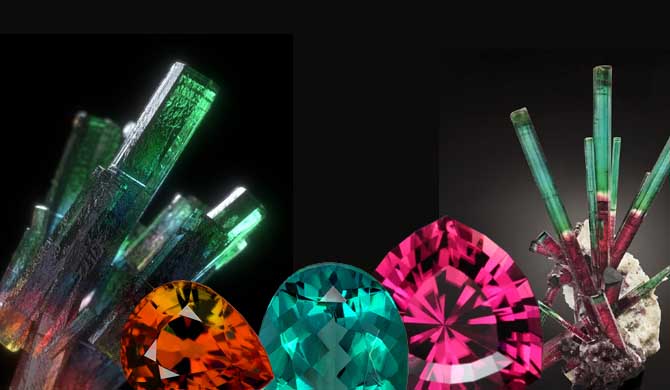If you were born in October you are very fortunate indeed to have such a stunning and versatile gemstone as your birthstone.
Egyptian legend maintains that during its formation, Tourmaline passed over a rainbow as it made its journey from the Earth’s center which led to it assuming the seven colors of the rainbow. Tourmaline is mined in a vast array of colors; the widest range of colors of any gemstone in the gem kingdom with virtually every color represented, including black, bi-colors and tri-colors.
TOURMALINE – The Philosopher’s stone
The popularity surrounding the Tourmaline gemstone did not start recently. In ancient times, it was used as an ornamental stone. The Egyptians, Greeks, and Romans, were convinced of its protective power, so they wore it as a talisman. During this period, black tourmaline was also associated with magic and sorcery. Legends have it that the great magicians of the time invoked this gemstone to protect themselves from demons and evil entities evolving on Earth.
A well-known philosopher, Theophrastus wrote his treatise “On Stones,” about lyncurium (tourmaline, most likely) and other minerals. Theophrastus’s bizarre beliefs hinted at the stone’s pyroelectric (static electricity) properties, as it attracted straw, ashes, and small pieces of wood. Because of its pyroelectric effect, alchemists considered it to be linked to the Philosopher;s stone. The stone’s abilities were, however, more worldly accepted 2000 years later, in 1707 in a book by author, Johann Georg Schmidt (Curious Speculations During Sleepless Nights), citing the Tourmalines’ magnetic properties. “The Turmale (Tourmaline) has the property of not only attracting the ashes from the warm or burning coals, as the magnet does iron but also repelling them again.” This fascination led to many findings and a naturalist Carl von Linné was the first to relate the pyroelectric property of tourmaline to electricity; he called the mineral ‘lapis electricus’—meaning electric stone.
The popularity of this colored stone continued to peak in the 17th century when Jewelers used it to adorn the crowns of Russian monarchs and in the 18th century, when Dutch merchants imported large quantities from Sri Lanka. They named it “asshentrekker”, meaning “ash headband”, because of its electrostatic properties. This natural stone was said to be beneficial to artists, writers, actors, and creators. And there we have it even today, still adorned by the indigenous tribes, famous artists, and world leaders.
IS TOURMALINE A PRECIOUS STONE?
Yes. Tourmaline is considered a precious and most sought-after stone. Its value stems from its rarity, versatility, beauty, and profound symbolic meanings.



